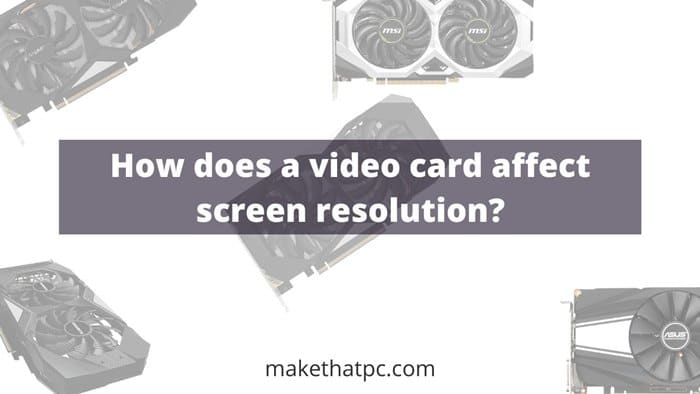It’s a no-brainer that almost every one of us has experienced the evolution of computers and their peripheral counterparts. If I say that they have undergone robust changes in the previous decade- it would be an understatement! Be it for gaming as well as for productivity, a high-defined video card can be your best friend. It not only manipulates and processes a great number of pixels but also helps to display any sharp image or video as crisp as possible.
Having said that, most PCs and laptops of today pack in integrated video cards by default, which can be of help while working on a daily basis. However, if you want to enhance the visual performance of your pc or laptop even further, you need to have a discrete video card. Upgrading it will help you realize the difference between the integrated one vs the one you bought to replace it. It is especially a must if you’re a gaming enthusiast, a pro video/photo editor, or a content creator.
In case you are new to this, don’t worry, I’m here to help you simplify the facts about video cards and their importance in screen resolution. With that said, If you want to know how video cards affect screen resolution or how video cards can improve the overall experience of visual performance, keep scrolling!

Importance of video cards in high-resolution display
Definitely, video cards or graphics cards can play a huge role in providing a high-resolution display on your screen. In fact, if you are using any kind of display with your computer, it is generated through some kind of Graphics Processing Unit.
So, for example, if you want to play a game in high-resolution, but you have a weak video card, you may not be able to do the same. The FPS may be compromised.
However, media consumption in a higher resolution will be easy with a video card but still, your card should have decent configurations to support it.
Encoding and decoding of video
Now, to understand the importance of video cards in screen resolution or rather a proper video displaying requires some attention. So, in many videos, the video codecs are still present, which can’t be detected by the CPU or graphics card. This is where a video card comes into play. Video cards can easily encode and decode, and maintain the constant output of videos. And let me tell you, it doesn’t affect the performance of the PC.
Calculation of the pixels
As you all know, the computer can display video or image because it receives power from the CPU (Central Process Unit) and GPU (Graphics Processing Unit) simultaneously. They both can work well in regard to video or image display. However, we can understand from the name itself that GPU deals with the calculation of the pixels that any intense video display would require.
With that being said, now we can talk about the relationship between screen resolution and video cards. Don’t start snoring yet… this is the important bit…
The monitor of any PC has limitations on screen resolution, and the video card’s performance can not function beyond that. Let me put it in simple terms: the monitor can be referred to as a bucket and the video card then would be water. It doesn’t matter how much water you want to put in the bucket, it would contain its limit only.
I hope that helps you understand the video cards’ effect on the screen resolution. Also, note as the video card works on FPS (Frame Per Second), the videos are displayed without shuttering or lags.
Screen resolution in Gaming
If you are a competitive gamer, the first requirement is to have a satisfying display of real-time responses. The in-game video rendering is most crucial here, as games nowadays are heavily graphic-driven (you all know what I’m talking about). So, you can never ignore the screen resolution.
But to say video cards can enhance video performance is not all, you need to understand the pros and cons too. Just in case something happens while playing a high-end video, you should at least understand the basic issue. The greater the screen resolution is the larger strain it puts on your video card.
So, if you want to run high-resolution videos you must not only upgrade your video card but your monitor as well in case the monitor isn’t enough to handle your video card. Most of us skip this step, but I want you all to not make this mistake.
With that said, different work intensities require different video cards. The video card built just for video editing would never be able to cope with the ultra-high resolution games. This would require a minimum resolution range of 1080p – 2160p. Therefore, if you want to play GTA V with a 2 GB video card, you must be ready to get disappointed. For the record, you would at least require a 6-8GB GDDR6/5X/5 video card.
Video cards affect screen resolution
Being said so much, it’s a no-brainer that the performance of the video cards affects the screen resolution. Once you understand this basic fact, you would try to switch or upgrade to a more compatible video card to be able to watch anything you like without being disrupted. You know how annoying feels when you are playing a high-end game or watching a high-resolution movie, and the video starts to lag.
Yes, you may argue that it also depends on the refresh rate. But come on if you don’t use a better video card, the refresh rate would not be able to fetch you any miracle.
Wrap up!
If you can’t play games and be productive at on your PC or laptop, it’s not worth the money spent. At the end of the day, it would only spoil your mood. However, just a simple up-gradation of the video card or switching to the latest one can help you get rid of the hassles of video shuttering, poor screen resolution, and quality.
Let’s assume you are just a casual gamer, but you want to binge-watch Netflix on 4K. Now believe me when I say, your experience would just be better with the up-gradation.
On the other hand, if you love to spend your time gaming, you don’t need to tell me anymore as you already know what is to be done to make your in-game experience better.

I am Anshul Rana, an experienced author specializing in PC gear reviews and Windows 10 software tutorials. With a strong passion for technology and an in-depth understanding of the PC industry, I provide insightful and detailed analyses of computer peripherals, gaming gear, and software solutions. My writing style is concise yet informative, making complex topics accessible to both beginners and advanced users. Through my reviews and tutorials, I aim to offer valuable guidance, helping readers make informed decisions to enhance their PC experience and explore the vast possibilities of Windows 10 software.









